Japanese Tradition: Gion Matsuri
Gion Matsuri: un’esperienza unica
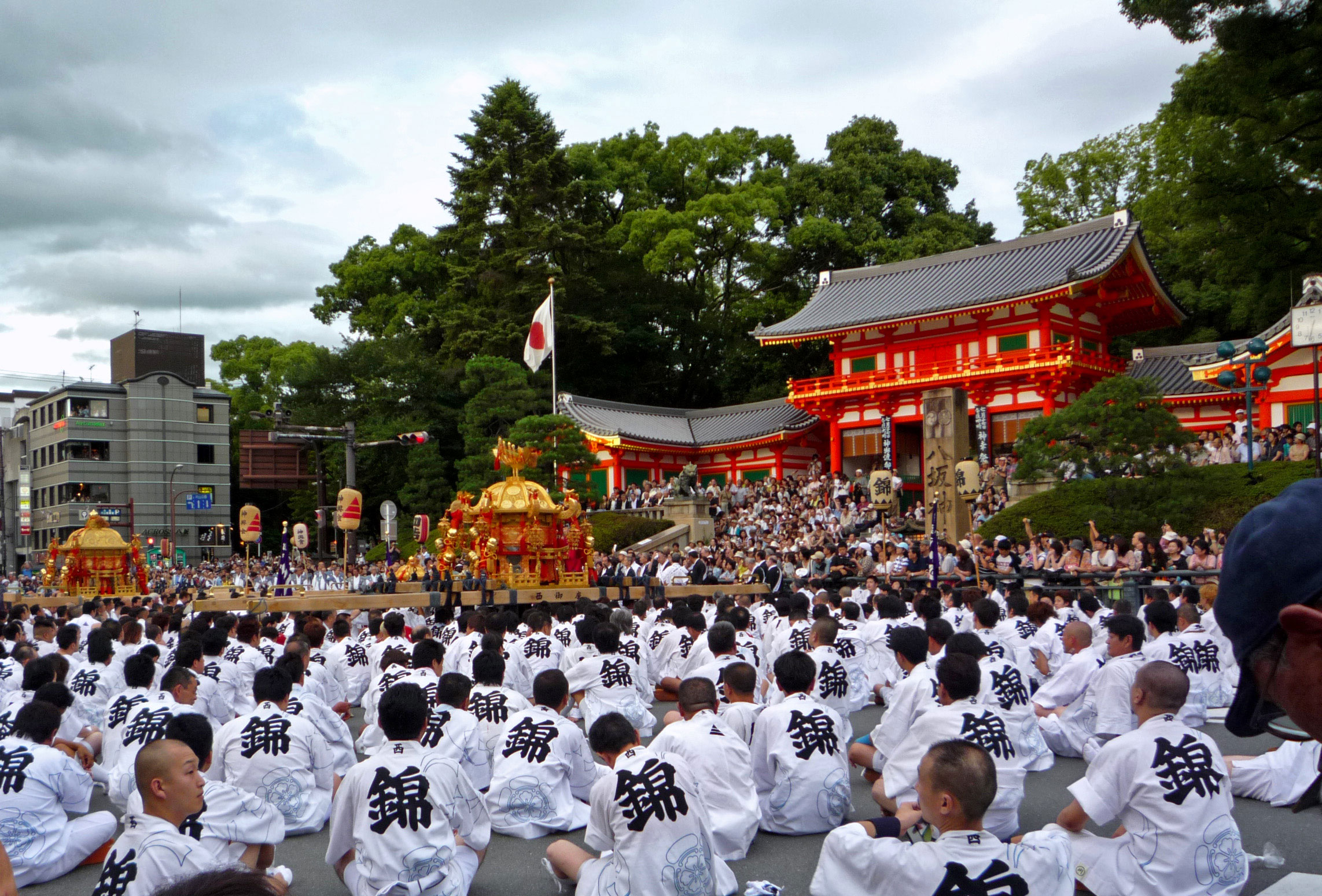
Photo credit: Daranice
La Festa di Gion o Gion Matsuri (祗園祭), così come viene chiamato a partire dall’epoca Meiji, prende il suo nome dal noto quartiere di Kyōto, Gion appunto, situato nel distretto di Higashiyama. Si tratta di una festa religiosa in onore del dio Susanoo, anche conosciuto come Takehaya Susanoo-no-Mikoto, venerato presso il santuario Yasaka.
Susanoo, dio del mare e delle tempeste, è anche signore del mondo dei morti, oltre ad essere fratello di Amaterasu da cui si dice discenda la stirpe degli imperatori giapponesi.
Insieme allo Aoi Matsuri (15 Maggio) e allo Jidai Matsuri (22 Ottobre), il Gion Matsuri costituisce una delle tre più grandi feste religiose di Kyōto, e del Giappone. Viene celebrato ogni estate per tutto il mese di luglio. Lo scopo è quello di placare gli spiriti dei defunti e invocare la protezione del dio sulla città per tenere lontano malattie e catastrofi naturali.
Come potete immaginare si tratta di un matsuri ricco di eventi. I principali e più spettacolari sono la Yamaboko Junkō ( 山鉾巡行, sfilata dei carri) e il Mikoshi Togyo (神輿渡御, l’uscita dei palanchini divini). Entrambi si svolgono tra il 17 luglio e il 24 luglio, giorni in cui la festa raggiunge il suo apice.
Una delle ragioni maggiori della spettacolarità di questo festival è sicuramente la grandezza dei carri utilizzati, in particolari quelli chiamati Hoko. Questi raggiungono anche i 25 metri di altezza per un peso di più di 10 tonnellate, e vengono trainati grazie a delle ruote alte circa due metri. Ogni carro viene ogni anno costruito dalle fondamenta, e poi smantellato al termine del festival, e tutti i pezzi sono tenuti insieme senza l’utilizzo di viti, come da tradizione.
Ma procediamo con ordine…
Un pò di storia

photo credit: kyotodeasobo.com
Tradizione vuole che il Gion Matsuri sia nato nell’anno 869. Da circa un secolo la corte imperiale giapponese si era sposta da Nara a Heiya-kyō (la odierna Kyōto) ed era dominata dalla potente famiglia Fujiwara.
Si dice che in seguito alla diffusione di un’epidemia, la Corte Imperiale decise di tenere il primo goryōe (御霊会), un rito purificatore tenuto presso il piccolo tempio Shinsen’en. Bisogna sapere che a quei tempi la città si trovava in una regione piuttosto paludosa dell’entroterra, molto calda ed umida. L’alta concentrazione di popolazione unita alla mancanza di fognature e condotte idriche spesso favoriva la contaminazione delle acque potabili con quelle di scolo. Non è quindi difficile immaginare che malattie come malaria, vaiolo, influenza e dissenteria fossero molto diffuse. Eppure, nell’antico Giappone la causa di tutto questo fu attribuita a ben altro.
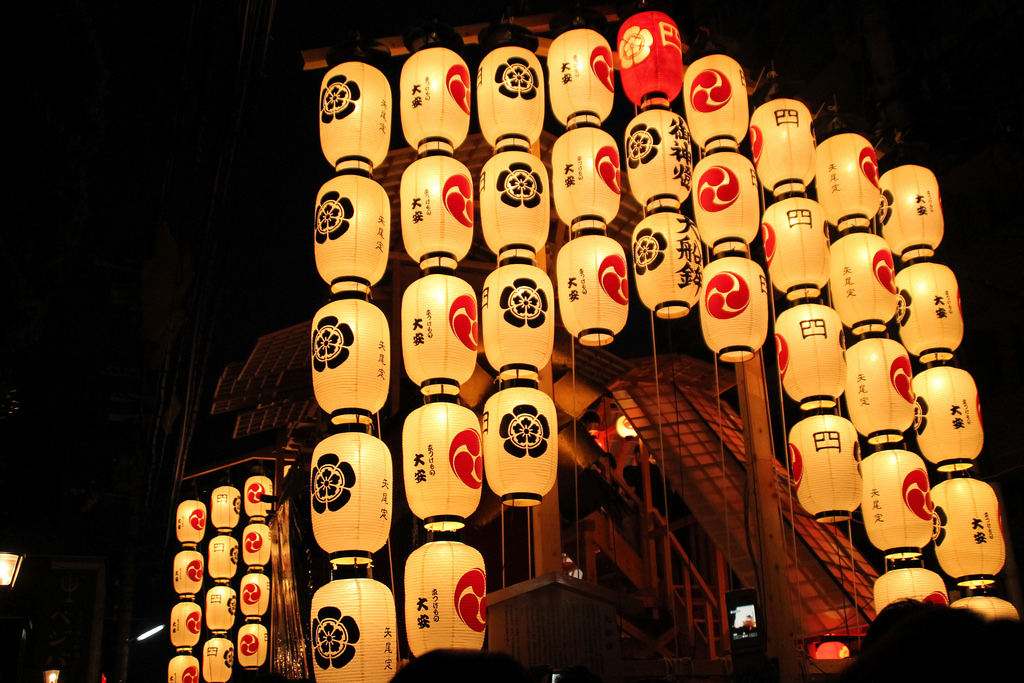
photo credit: japancheapo.com
Secondo le predizioni di un maestro divinatore i veri responsabili dell’epidemia erano degli spiriti malvagi, ovvero i fantasmi del principe Sawara Shinnō e dei suoi compagni. Questi, accusati dell’omicidio del nobile Fujiwara no Tanetsugu, erano morti professando fino alla fine la loro innocenza.
Nel tentativo di calmare gli spiriti si tenne quindi il primo goryōe con invocazione al dio Susanoo. Inoltre, il nobile Urabe Hiramaru fece erigere 66 lance, una per ogni provincia del Giappone, in modo da rinchiudere al loro interno gli spiriti malvagi e purificare la capitale.
Proprio qui nacque l’usanza di portare in processione tre mikoshi, o palanchini divini, e di tenere un goryōe ogni volta che una epidemia o malattia si diffondeva. Il tutto era contornato da altre celebrazioni e momenti gioviali.
Fino al 970, quando venne stabilito che il Gion Goryōe (祗園御霊会) si dovesse svolgere regolarmente ogni anno.
Successivamente, a partire dal periodo Muromachi, l’evento fu arricchito ulteriormente dalla presenza dei tipici carri, gli yamaboko (山鉾), anche essi fatti sfilare per le vie della città. Questi erano costruiti grazia alla collaborazione del ceto mercantile che proprio in questo periodo vive un momento di forte ascesa dopo secoli di denigrazione. I carri venivano adornati con decorazioni che si fecero nel tempo sempre più ricche e sofisticate.
Insomma, la sfilata divenne anche un modo per esibire la ricchezza del ceto mercantile.
Nonostante brevi interruzioni (durante la guerra Ōnin (1467-1477) e durante la seconda guerra mondiale (1941-1945) ), il festival viene ancora oggi mantenuto vivo e può vantare una storia lunga più di mille anni.
I festeggiamenti
I festeggiamenti che come dicevamo durano per tutto il mese di luglio coinvolgono tutte le varie aree della città.
Si inizia il primo di luglio, quando presso il santuario Yasaka si tiene la cerimonia del Kippuiri (吉符入). Qui, i rappresentanti dei quartieri responsabili dell’organizzazione pregano perché tutto si svolga tranquillamente e senza incidenti.
Il 2 luglio, presso il palazzo comunale di Kyōto, si svolge una estrazione presieduta dal sindaco della città con cui viene scelto l’ordine di processione dei carri. Aprire la processione però spetta sempre al Naginataboko (長刀鉾).

photo credit: heterophyllum
Il 10 luglio vengono preparati i mikoshi (神輿), tre palanchini che ospiteranno tre piccoli tempietti dedicati al dio Susanoo. Contemporaneamente, alcuni secchi vengono calati dal ponte Shijō per raccogliere dal sacro fiume Kamo l’acqua destinata al lavaggio dei mikoshi. Nel tardo pomeriggio si tiene poi una sfilata esibendo lanterne di carta di manifattura tradizionale che serviranno ad accogliere il dio.
Sempre il 10 luglio ha inizio anche la costruzione dei carri e passeggiando per le vie del centro di Kyōto potrete osservarli prendere lentamente forma sotto le mani sapienti dei loro costruttori.
I giorni tra il 14 al 16 luglio sono quelli che precedono la festa vera e propria. Il 14 luglio è conosciuto come yoi-yoi-yoi-yama (宵々々山), il 15 luglio come yoi-yoi-yama (宵々山) mentre il 16 è chiamato yoi-yama (宵山). Lo stesso varrà per il 21,22 e 23 luglio. In questi giorni, a partire dalle ore 6:00 del pomeriggio, le vie del centro chiuse al traffico si riempiono del vociare di passanti e turisti. Si passeggia tra le numerose bancarelle, alla luce delle lanterne tenute sempre accese, ammirando yamaboko.
Sempre in questo periodo, le famiglie più antiche della città aprono le finestre delle loro case permettendo così ai passanti di ammirare i tesori che custodiscono da generazioni.
Il 15 luglio, si tengono lo imitaketate (斎竹建) e lo yoimiya-sai (宵宮祭). Il primo è un rito durante il quale si dispongono a quadrato dei tronchi di bambù intorno all’area in cui si svolgerà la processione per proteggerla da ogni contaminazione. Lo yoimiya-sai si tiene invece presso il santuario di Yasaka, durante il quale lo spirito della divinità viene trasferito nei tre mikoshi purificati.
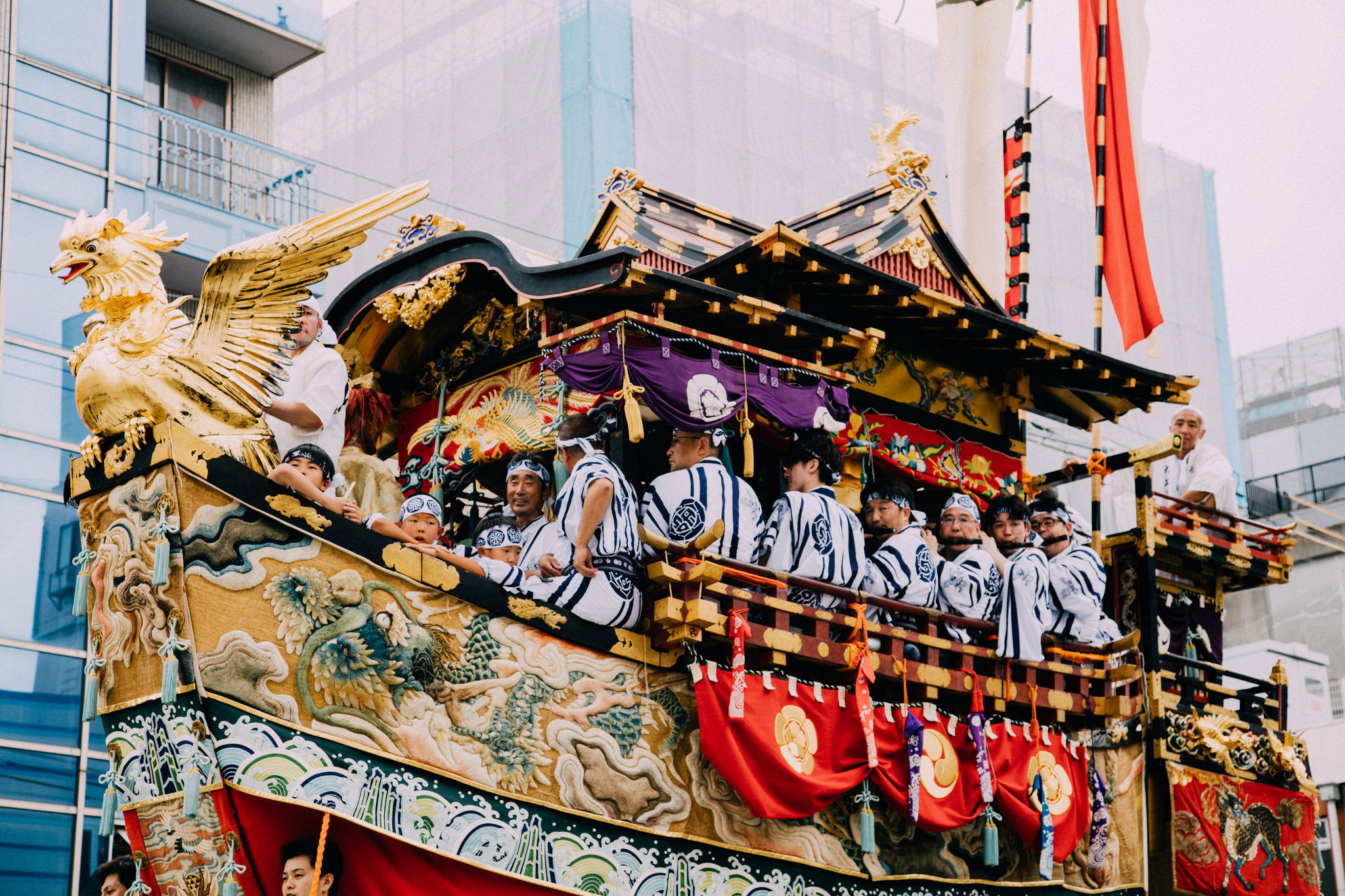
photo credit: Tomomi Onishi
Il 16 luglio i musicanti di ogni carro si recano al tempio per pregare per il bel tempo il giorno successivo e non mancano spettacoli musicali e di danza per le strade.
Il 17 luglio è l’atteso giorno in cui la festa raggiunge il suo culmine. È il momento dello Yamaboko Junkō, la grande sfilata dei carri. Questi vengono divisi in 2 gruppi gli yama 山 (montagna) e gli hoko 鉾 (lancia) appunto. Il primo gruppo è formato dai 9 carri hoko, e simboleggiano le 66 lance utilizzate da Urabe Hiramaru per scacciare gli spiriti maligni. Il secondo gruppo è formato dai 23 carri yama, più piccoli, che trasportano rappresentazioni a grandezza naturale di personaggi importanti e famosi.
Ogni carro hoko trasporta musicanti che ne accompagnano la processione.
Kon-kon chiki-chin, kon-kon chiki-chin… questo è il suono distintivo del Gion Matsuri, una ritmo tradizionale risalente al periodo Edo.
E non mancano per le strade danzatori ed acrobati di vario genere a rendere la parata ancora più allegra e movimentata. Ovviamente tutti sono vestiti con costumi colorati e rigorosamente tradizionali.
Come già detto ad aprire la parata sarà il carro Naginata-boko. Viene così chiamato per via di una naginata (tipica lancia giapponese) che svetta verso l’alto sulla sua cima. Si dice che essa abbia il potere di scacciare spiriti maligni e pestilenze. La naginata originale di epoca Heian era stata forgiata in metallo, mentre quella che oggi possiamo ammirare è fatta in bambù.
Sul Naginataboko viene trasportato anche un chigo, (稚児), un bambino vestito con ricchi abiti tradizionali e un copricapo a forma di fenice dorata. Questo bambino ha il compito di rappresentare il dio durante la festa.
Il prescelto, solitamente selezionato tra le più importanti famiglie di mercanti e commercianti di Kyōto, deve sottoporsi ad un lungo periodo di preparazione prima di poter ricoprire questo ruolo. Settimane di riti purificatori e di completo isolamento, lontano da tutto ciò che potrebbe contaminarlo, e quindi anche dalle donne. Non gli è nemmeno permesso di toccare il suolo comune ma viene portato in spalla da uomini incaricati del suo trasporto
Al bambino spetterà il compito di tagliare con un solo colpo una grossa corda sacra realizzata in paglia. È lo Shimenawa-kiri (しめ縄切り), atto con cui la divinità entra nel mondo terreno recidendo il confine che separa i due mondi, e con questo gesto viene dato ufficialmente inizio alla grande festa.
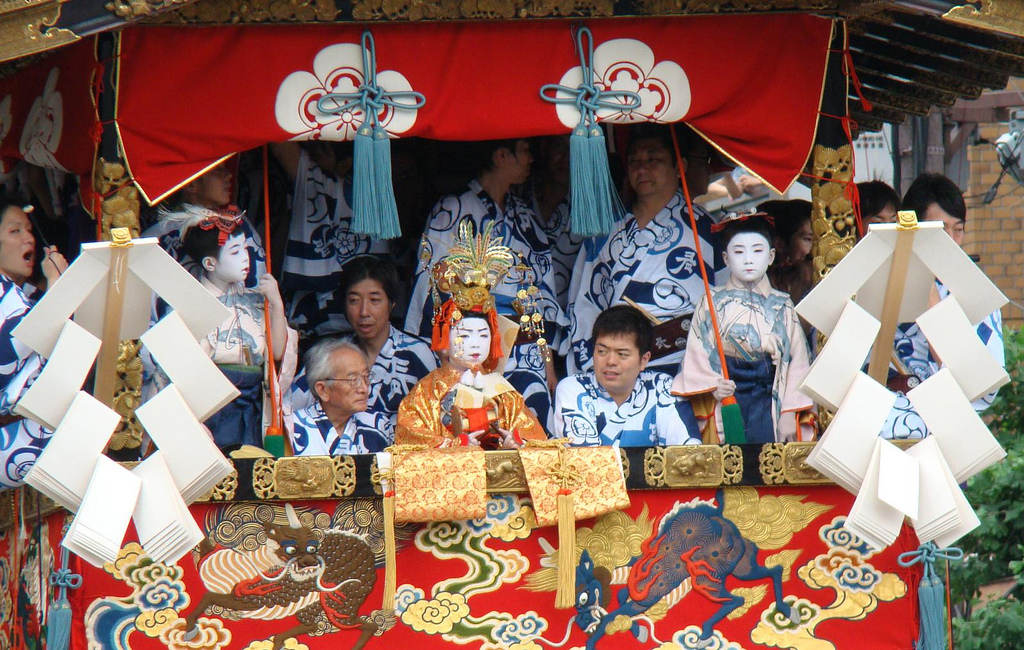
photo credit: picssr.com
Nel tardo pomeriggio, si assiste invece all’uscita dal tempio dei palanchini divini ovvero il mikoshi togyo. È il momento tanto atteso dello Shinkō-sai (神幸祭), ovvero l’uscita della divinità dal tempio con i palanchini portati a spalla per le vie della città.
Il 24 luglio questa doppia sfilata viene ripetuta e alla sera i tre mikoshi vengono riportati al tempio al tempio. È il momento del Kankō-sai (還幸祭), con il quale lo spirito del dio ritorna definitivamente al mondo che gli appartiene.
Al termine della sfilata i carri vengono immediatamente smantellati e conservati per il festival successivo.

photo credit: Tomomi Onishi
Lo stesso giorno si svolge la Hanagasa Junkō (花傘巡行), evento che come suggerisce il nome stesso ha come protagonista i fiori. Questo nome viene infatti scritto con i caratteri di hana (花) ovvero fiore, e kasa (傘) ovvero ombrello. Durante questa parata, i carri e le persone che sfilano sono tutti adornati da ombrelli e cappelli abbelliti da fiori.
La parata è aperta da piccoli mikoshi trasportati questa volta da bambini e al loro seguito troviamo un corteo numerosissimo di persone in abiti tradizionali. Ci sono i rappresentanti di associazioni culturali e commerciali, musicisti, danzatori,acrobati e in particolare alcune tra le più note geisha e maiko della città. E sono proprio loro i fiori più belli da mettere in mostra.
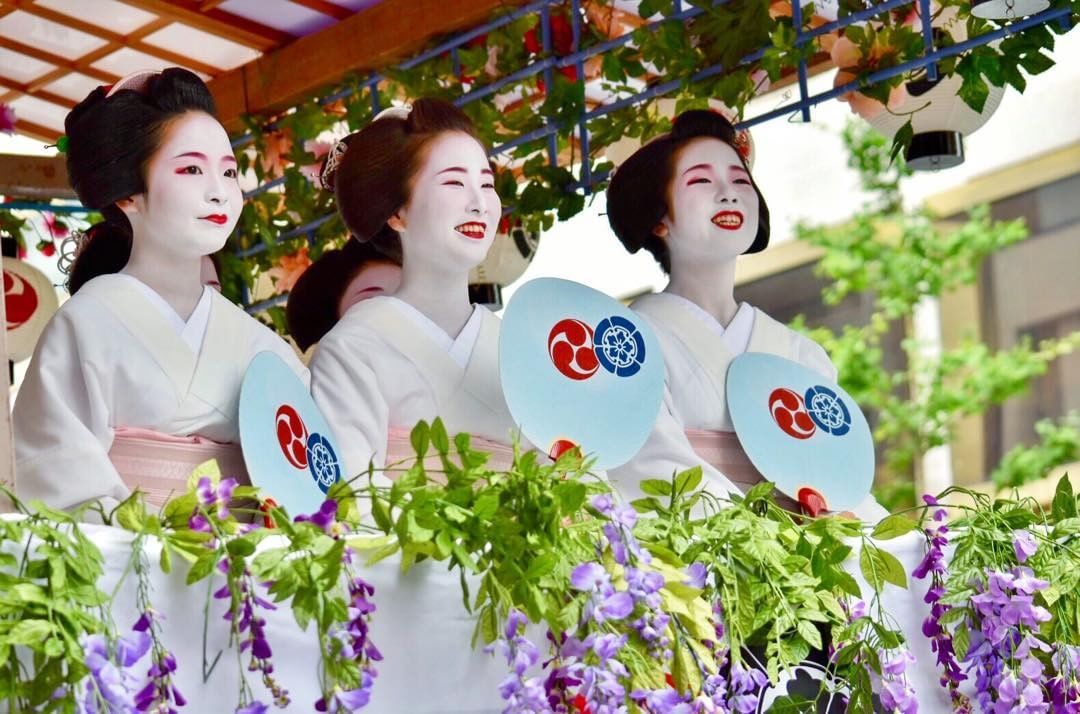
photo credit: geimei.tumblr.com
Il 28 luglio c’è la cerimonia del mikoshi-arai (神輿洗式), il lavaggio dei mikoshi presso il santuario Yasaka, per purificare i palanchini, fino al prossimo anno.
Se vi trovate nei paraggi non perdevi questo momento. Si dice infatti che porti fortuna essere colpiti dagli schizzi dell’acqua destinata al dio.
A segnare la fine del Gion Matsuri è il festival del nagoshisai (夏越祭), che si tiene ogni anno il 31 di luglio presso il santuario Ekijin.
Legato al torii, il ‘cancello’ che segna l’ingresso dell’area sacra del tempio, si trova una grossa corda di paglia intrecciata a formare un cerchio del diametro di due metri, lo Chinowa (茅の輪).
Passate pure attraverso questo grande cerchio per essere purificati, e ricevere poi un talismano di protezione sul quale troverete scritto “Somin-shorai shison nari(蘇民将来子孫也) che significa “Sono un discendente di Somin Shorai”. Secondo la leggenda Somin Shorai era un uomo umile che un giorno accolse in casa un viandante che era già stato rifiutato da un ricco signore. Il viandante era in realtà una divinità che per ringraziarlo della sua ospitalità gli insegno come costruire questi talismani porta fortuna. Da allora si crede che questi abbiano il potere di allontanare catastrofi e ladri.
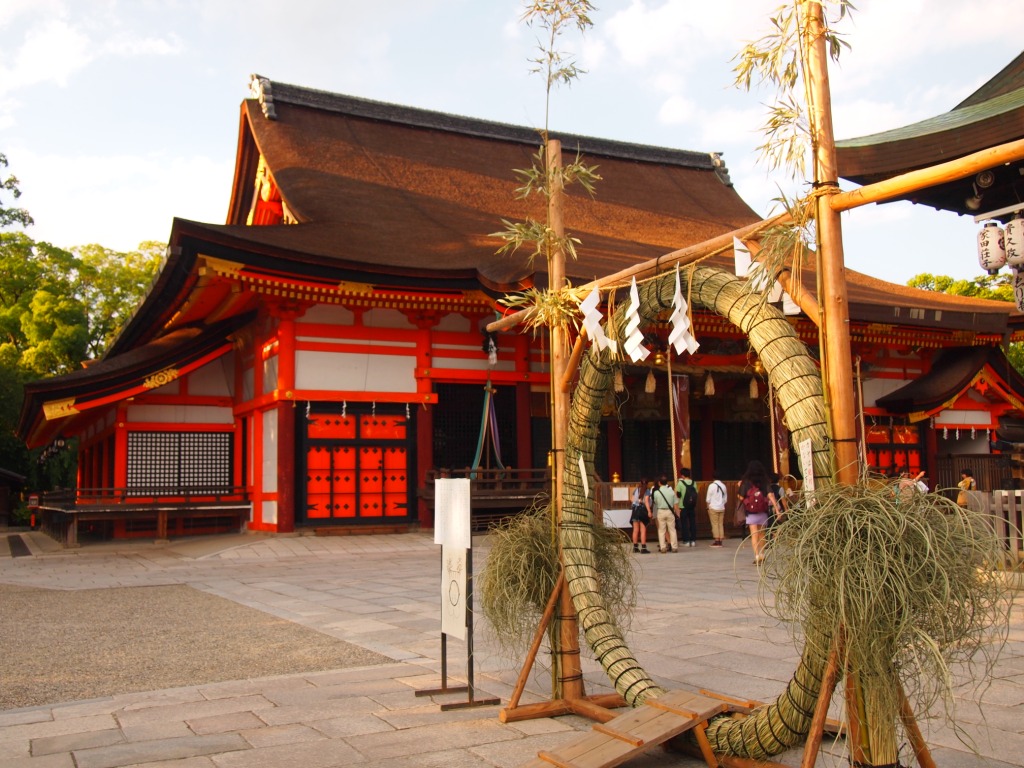
photo credit: kyoto-tabiya.com
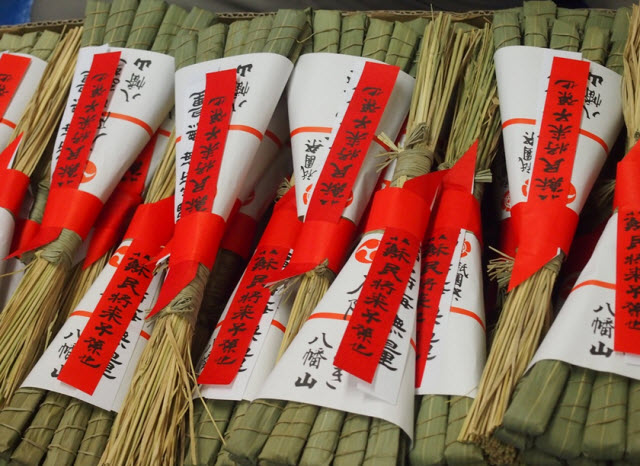
photo credit: kyotoiju.com
Quello del Gion Matsuri è un lungo viaggio in cui si intrecciano storia e leggenda, religione e spettacolo. Un evento unico nel suo genere.
E voi? Avete mai avuto occasione di prendervi parte? Aspettiamo i vostri commenti e le vostre esperienze!
Condividi:
- Fai clic per condividere su Facebook (Si apre in una nuova finestra)
- Fai clic qui per condividere su Twitter (Si apre in una nuova finestra)
- Fai clic qui per condividere su Tumblr (Si apre in una nuova finestra)
- Fai clic qui per condividere su Pinterest (Si apre in una nuova finestra)
- Fai clic per condividere su Telegram (Si apre in una nuova finestra)
- Fai clic per condividere su WhatsApp (Si apre in una nuova finestra)
- Fai clic qui per condividere su Reddit (Si apre in una nuova finestra)
- Fai clic qui per stampare (Si apre in una nuova finestra)






